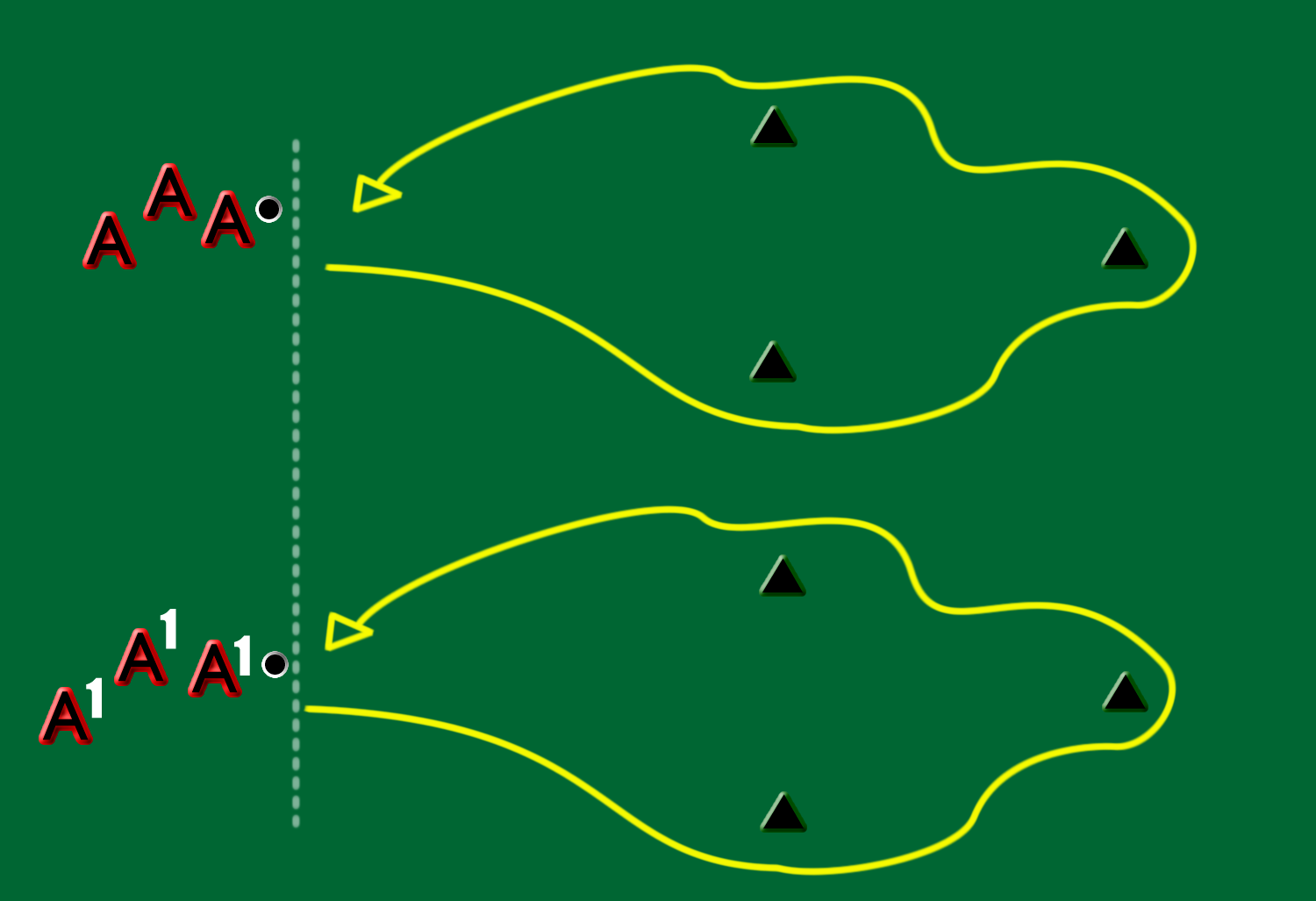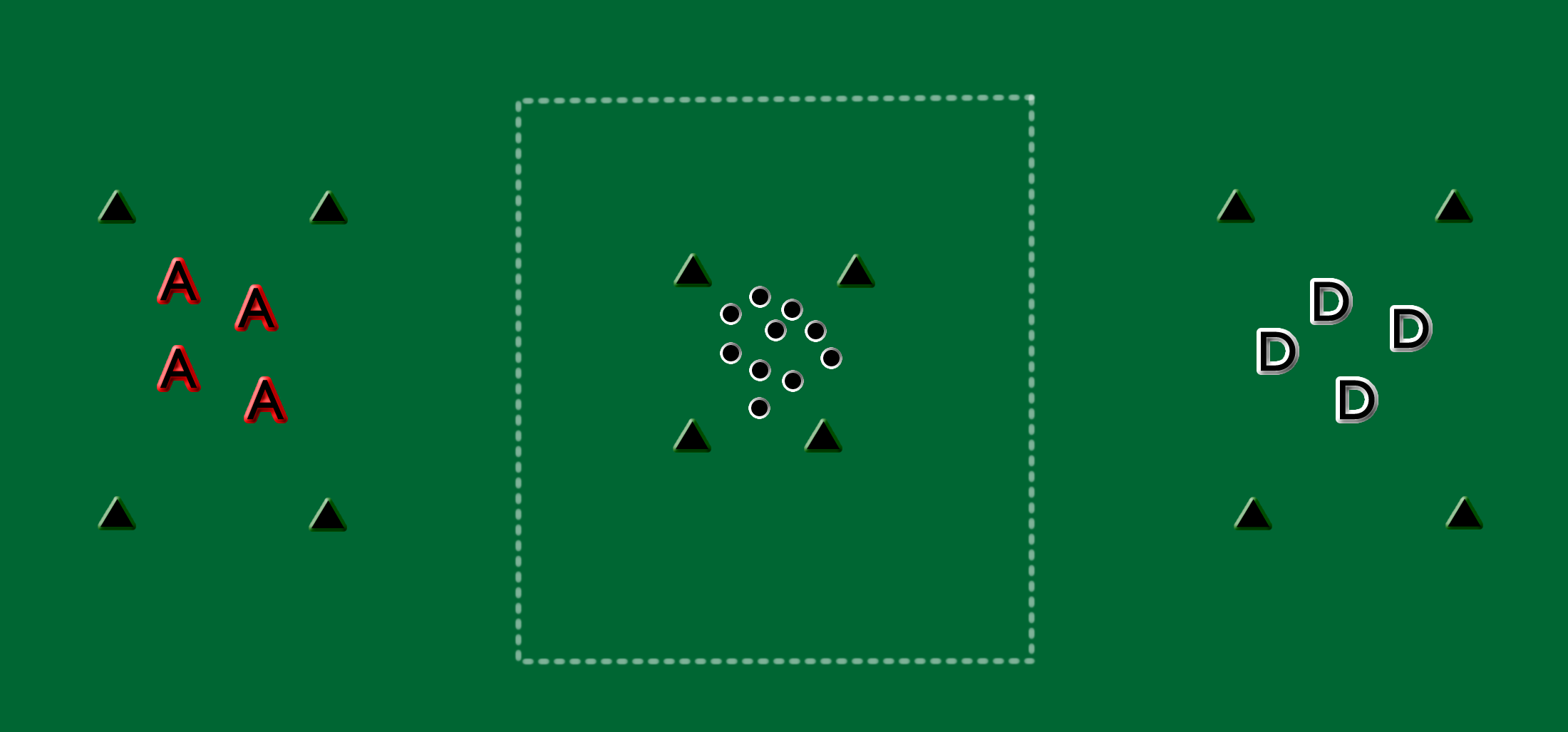FUNSTIX - Lesson 1
THEMES- FMS: running, changing pace and direction, footwork, agility, balance (basic stance), eye hand coordination, peripheral vision.
TECHNICAL : standard grip, running with the ball, straight and tap dribble TACTICAL: recognize open space
Activity 1
i) 4 minutes Crowded Streets - In a defined area, using running, skipping, and stopping movements, children move in space trying to stay as far away from each other as possible; children change direction (left, right) and speed (walk, slow jog, fast run) on instructor’s command; children alternate running, skipping, stopping (assuming the basic stance), and starting, on instructor’s command, always moving to open space
ii) 2 minutes Home and Away - Children jog in a 20 by 20 yard square; instructor calls out “home” and players move into a small huddle as quickly as possible; instructor then calls “away” and children move as fast as they can and spread out as much possible into open spaces. Players must use different locomotor actions each time they try to find open space. MAKE THIS ACTIVITY HARDER: Gradually make the space smaller
iii) 4 minutes Can’t Get Me * - 20 yard square with 5 cones randomly placed well apart in the space; two players are identified as the ‘it’ players who are trying to tag the other players who are moving around the playing area; players cannot be tagged if they are in contact with a cone. Only one player can be on a cone at any time and players can only stay on a cone for 5 seconds. If a player is tagged, they change places with the tagger. MAKE THIS ACTIVITY HARDER; reduce the number of cones and make the space smaller. To ensure safety, control the speed by incorporating movements such as skipping, sidesteps, and shuffle steps.
Activity 2
i) 1 minute Juggling Jokers - Players line up one beside the other, along a line, with ample space between each player. Each player has a ball, but no stick. Players place the ball on the palm of their hand (right or left) and try to bounce the ball in and out of the palm of their hand without catching it and with out dropping it. Repeat the same activity with the other hand. Count the number of times they can bounce the ball without dropping it.
ii) 3 minutes Moving Jugglers - Organize players in lines of no more than 3. One after the other, players walk, or run, while bouncing the ball in their hand around the cones, returning to the start position. MAKE THIS ACTIVITY EASIER: players can go more slowly, and use both hands, or simply catch the ball and toss it up. MAKE THIS ACTIVITY HARDER: players should be required to skip and turn while juggling the ball.

Activity 3
i- 8 minutes Running With the Ball Players line up one beside the other, along a line, with ample space between each player. Each player has a ball and a stick. Players stand with their right foot forward and place the ball on the right side of their body outside of their right foot. With the stick placed behind the ball and using the correct grip, players run with the ball to a line 20 yards away trying to keep the stick constantly in contact with the ball. Repeat 4 times.
ii- 8 minutes Repeat the activity using the tap dribble
iii- 8 minutes Around the Cones Organize players in lines of no more than 3. One after the other, players carry the ball around the cone path returning to the start position. MAKE THIS ACTIVITY EASIER: players can go more slowly; players can stop at each cone. MAKE THIS ACTIVITY HARDER: add a time limit; vary the footwork (use a shuffle step); count out loud while dribbling
Activity 4
10 minutes Rob the Nest * Divide players into each 2 groups (no more than 4 players per group). Each group stands behind their endline inside a 10 yard square. In the middle of the playing area, 4 cones are placed in a 10 yard square; a cone of squares. In the middle of the square there are 10-15, or more, hockey balls. On the instructor’s signal, players from each team run to the square place their stick on a ball and using the straight or tap dribble, carry the ball back across their own line. When all of the balls have been taken from the middle, teams try and steal balls from the other team’s nest…no tackling is allowed. After a set period of time, the team with the most balls wins the game. MAKE THIS ACTIVITY HARDER: scatter cones outside of the square so that players have to dribble around them to get back to their line; require players to use shuffle steps and only the straight dribble.

LESSON 1 CONTENT LEARNING DESCRIPTORS
FUNDAMENTAL MOVEMENT SKILLS
|
RUNNING: run on the balls of the feet, head-up and looking forward, bend knees, relax upper body, arms alternate forward and back with bent elbows and in opposition to the legs,
CHANGING DIRECTION/AGILITY: maintain a wide stance with body weight somewhat crouched in order to move laterally and change direction; keep your body in control while moving, move on the balls of the feet, lean in the direction of travel, to start quickly and away from the direction of travel to stop quickly, vary speed, stay low in order to change direction quickly, bend the knees when landing, pretend to move one way and then move in a different direction, when running backwards keep your weight over your feet
BALANCE: centre of gravity (belly button) is kept low and should be directly over the centre of the base of support; the wider the part that contacts the floor, the easier it is to balance, the stiffer the body the easier it is to balance; knees should be bent and feet should be shoulder width apart for maximum balance
AGILITY: is the quick movement of the feet and the body, in different directions, at different levels, in small spaces, with multiple stops and starts, accelerations and decelerations. Good agility and footwork is essential for success in all physical activities and sports.
SKIPPING: is a series of step hops done with alternate feet. Teach skipping by having learners step and then hop on the same foot and then step and hop on the other foot swing arms to shoulder height in opposition with the feet, skip on the balls of the feet, keep movements smooth, speed and distance are not important, transfer weight from one foot to the other while doing the hop, step-hop, swing smoothly.
SHUFFLE: the feet move in the following sequence-right, left, right; left, right left, the weight is on the balls of the feet with the knees slightly bent; the feet move quickly with short steps and the back foot never passes the front foot; the ffet stay close to the ground.
SIDESTEPS: the body moves left or right with the side of the body leading and the toes of the feet at right angles to the direction of travel; the steps should be short, weight is on the balls of the feet, primarily on the leading leg with the trailing foot touching the ground and quickly pushing off. The feet should be close to the ground during sidesteps.
BASIC STANCE (READY POSITION): feet shoulder width apart, keep feet below your shoulders; left foot slightly ahead of the right; weight low (sit); head Stick head rests on the ground in front and slightly to the right of the body. Player should be looking forward with head up for maximum vision and not down at their feet.
TECHNICAL: Standard Grip: Place the stick vertically out in front of body and lay it on the ground with the flat side of stick facing down. Reach over to pick up the stick at the top of the handle with the left hand only using a handshake grip. This should cause a “V” shape to be formed with the thumb and remaining fingers once the hand is wrapped around the stick. Reach for the shaft of the stick midway down and loosely grips the stick. This looseness allows for the left hand to be able to turn the stick quickly and in more control. Left hand is known as the “control” hand while the right hand “guides” the stick through movement. Knees are bent; feet are staggered (left foot forward, right foot back slightly). Stick head rests on the ground in front and slightly to the right of the body. Straight Dribble: Straight (Silent Dribble): Stick should be held on the right side of the body (roughly in line with right foot): ball stays in contact with stick the entire time; the ball should be far enough out in front so that player can look up and still see the ball; Ball remains on flat-side of stick. Stick and body position: Stick is out in front of body, away from feet and just slightly to the right with the head of the stick touching the ground. Stick is angled at 45° to the floor. The left arm is extended out and away from the body with the back of the left hand leading forward in the intended direction of movement. The right hand remains midway on the shaft of the stick but with a relaxed grip. Knees are slightly bent and head looks up often and faces forward for clear vision of the field Action: Move forward while pushing the ball along on the stick. Players will need to use good footwork to readjust their body position, feet and stick to remain behind ball. Make sure the player is not trying to carry the ball too far to the side. The ball is kept in front and just slightly off the right foot to allow for a strong, protective stance on the ball and the quick ability to change direction while maintaining control of the ball. Stick angle should be kept at 45° to the floor with left hand away from body Tap Dribble: From the Straight Dribble, the right hand lightly extends, pushing the ball away from the stick. The player taps the ball forward and runs onto it.
TACTICAL: Open Space; a space in the playing area where no one is standing |
- Fundamentals (1.63 MB)
- Fundamentals (1.71 MB)
- Fundamentals (1.49 MB)
Filtering
Instructions for Filtering the Resource Centre.
Click on a specific tag in the filter list to view articles and resources related to that tag.
For example, click on Attacking to filter the resource centre for attacking.
You can also do keyword based searching.

